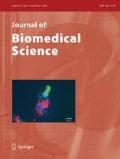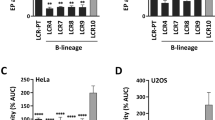Abstract
Human cytomegalovirus (HCMV) is a ubiquitous human pathogen that is the leading viral cause of birth defects and also causes significant morbidity and mortality in immunosuppressed individuals. The immediate early (IE) genes, IE1-p72 and IE2-p86, are the first HCMV genes expressed after infection under the control of a strong transcriptional enhancer-promoter, the major IE promoter (MIEP). Gene expression mediated by the predominant IE2-p86 is believed to be essential for the progression of viral production, as well as for the development of HCMV-associated pathogenesis. To gain further understanding of the transcriptional activity of IE2-p86, we attempted to isolate its downstream target genes within the HCMV genome. By a modified approach coupling the methods of cyclic amplification and selection of targets and selection and amplification of binding sites, several HCMV genomic fragments were identified based on their ability to bind to IE2-p86. Two additional IE2-p86-responsive elements other than thecis-repressive sequence (CRS) were identified within the MIEP and were termed −240 and −170 boxes. These twocis elements resemble the CRS in their sequences, as they contain the CG(N)10CG motif. The binding of IE2-p86 to these two distal CRS-like sequences was further confirmed by DNase I footprinting analysis and electrophoretic mobility shift assay. Promoter activity analysis in the transient expression system suggested that these twocis elements act functionally as IE2-p86-responsive repressive sequences to cooperate with the CRS to suppress MIEP expression.
Similar content being viewed by others
References
Ahn JH, Chiou CJ, Hayward GS. Evaluation and mapping of the DNA binding and oligomerization domains of the IE2 regulatory protein of human cytomegalovirus using yeast one and two hybrid interaction assays. Gene 210:25–36;1998.
Arlt H, Lang D, Gebert S, Stamminger T. Identification of binding sites for the 86-kilodalton IE2 protein of human cytomegalovirus within an IE2-responsive viral early promoter. J Virol 68:4117–4125;1994.
Blackwell TK, Kretzner L, Blackwood EM, Eisenman RN, Weintraub H. Sequence-specific DNA binding by the c-Myc protein. Science 250:1149–1151;1990.
Blackwell TK, Weintraub H. Differences and similarities in DNA-binding preferences of MyoD and E2A protein complexes revealed by binding site selection. Science 250:1104–1110;1990.
Bresnahan WA, Albrecht T, Thompson EA. The cyclin E promoter is activated by human cytomegalovirus 86-kDa immediate early protein. J Biol Chem 273:22075–22082;1998.
Britt WJ, Alford CA: Cytomegalovirus, ed 3. Boston, Lippincott-Raven, 2493–2523;1996.
Caswell RC, Hagemeier C, Chiou CJ, Hayward G, Kouzarides T, Sinclair J. The human cytomegalovirus 86 K immediate early (IE) 2 protein requires the basic region of the TATA-box binding protein (TBP) for binding, and interacts with TBP and transcription factor TFIIB via regions of IE2 required for transcriptional regulation. J Gen Virol 74:2691–2698;1993.
Chan YJ, Chiou CJ, Huang Q, Hayward GS. Synergistic interactions between overlapping binding sites for the serum response factor and ELK-1 proteins mediate both basal enhancement and phorbol ester responsiveness of primate cytomegalovirus major immediate-early promoters in monocyte and T-lymphocyte cell types. J Virol 70:8590–8605;1996.
Chen J-Y, Funk WD, Wright WE, Shay JW, Minna JD. Heterogeneity of transcriptional activity of mutant p53 proteins and p53 DNA target sequences. Oncogene 8:2159–2166;1993.
Cherrington JM, Khoury EL, Mocarski ES. Human cytomegalovirus IE2 negatively regulates α gene expression via a short target sequence near the transcription start site. J Virol 65:887–896;1991.
Chiou CJ, Zong J, Waheed I, Hayward GS. Identification and mapping of dimerization and DNA-binding domains in the C terminus of the IE2 regulatory protein of human cytomegalovirus. J Virol 67:6201–6214;1993.
Funk WD, Pak DT, Karas RH, Wright WE, Shay JW. A transcriptionally active DNA-binding site for human p53 protein complexes. Mol Cell Biol 12:2866–2871;1992.
Funk WD, Wright WE. Cyclic amplification and selection of targets for multicomponent complexes: Myogenin interacts with factors recognizing binding sites for basic helix-loop-helix, nuclear factor 1, myocyte-specific enhancer-binding factor 2, and COMP1 factor. Proc Natl Acad Sci USA 89:9484–9488;1992.
Hagemeier C, Walker S, Caswell R, Kouzarides T, Sinclair J. The human cytomegalovirus 80-kilodalton but not the 72-kilodalton immediate-early protein transactivates heterologous promoters in a TATA box-dependent mechanism and interacts directly with TFIID. J Virol 66:4452–4456;1992.
Hermiston TW, Malone CL, Stinski MF. Human cytomegalovirus immediate-early 2 protein region involved in negative regulation of the major immediate-early promoter. J Virol 64:3532–3536;1990.
Hupp TR, Meek DW, Midgley CA, Lane DP. Regulation of the specific DNA binding function of p53. Cell 71:875–886;1992.
Jupp R, Hoffmann S, Depto A, Stenberg RM, Ghazal P, Nelson JA. Direct interaction of the human cytomegalovirus IE86 protein with the cis repression signal does not preclude TBP from binding to the TATA box. J Virol 67:5595–5604;1993.
Jupp R, Hoffmann S, Stenberg RM, Nelson JA, Ghazal P. Human cytomegalovirus IE86 protein interacts with promoter-bound TATA-binding protein via a specific region distinct from the autorepression domain. J Virol 67:7539–7546;1993.
Klucher KM, Sommer M, Kadonaga JT, Spector DH. In vivo and in vitro analysis of transcriptional activation mediated by the human cytomegalovirus major immediate-early proteins. Mol Cell Biol 13:1238–1250;1993.
Lang D, Fickenscher H, Stamminger T. Analysis of proteins binding to the proximal promoter region of the human cytomegalovirus IE-1/2 enhancer/promoter reveals both consensus and aberrant recognition sequences for transcription factors Sp1 and CREB. Nucleic Acids Res 20:3287–3295;1992.
Lang D, Gebert S, Arlt H, Stamminger T. Functional interaction between the human cytomegalovirus 86-kilodalton IE2 protein and the cellular transcription factor CREB. J Virol 69:6030–6037;1995.
Lang D, Stamminger T. The 86-kilodalton IE-2 protein of human cytomegalovirus is a sequence-specific DNA-binding protein that interacts directly with the negative autoregulatory response element located near the cap site of the IE-1/2 enhancer-promoter. J Virol 67:323–331;1993.
Lang D, Stamminger T. Minor groove contacts are essential for an interaction of the human cytomegalovirus IE2 protein with its DNA target. Nucleic Acids Res 22:3331–3338;1994.
Lee CH, Lee GC, Chan YJ, Chiou CJ, Ahn JH, Hayward GS. Factors affecting human cytomegalovirus gene expression in human monocyte cell lines. Mol Cells 9:37–44;1999.
Lee G, Wu J, Luu P, Ghazal P, Flores O. Inhibition of the association of RNA polymerase II with the preinitiation complex by a viral transcriptional repressor. Proc Natl Acad Sci USA 93:2570–2575;1996.
Liu B, Hermiston TW, Stinski MF. A cis-acting element in the major immediate-early (IE) promoter of human cytomegalovirus is required for negative regulation by IE2. J Virol 65:897–903;1991.
Macias M, Stinski MF. An in vitro system for human cytomegalovirus immediate early 2 protein (IE2)-mediated site-dependent repression of transcription and direct binding of IE2 to the major immediate-early promoter. Proc Natl Acad Sci USA 90:707–711;1993.
Meier J, Stinski MF. Regulation of human cytomegalovirus immediate-early gene expression. Intervirology 39:331–342;1996.
Ouellette MM, Chen J, Wright WE, Shay JW. Complexes containing the retinoblastoma gene product recognize different DNA motifs related to the E2F binding site. Oncogene 7:1075–1081;1992.
Pizzorno MC, Hayward GS. The IE2 gene products of human cytomegalovirus specifically down-regulate expression from the major immediate-early promoter through a target sequence located near the cap site. J Virol 64:6154–6165;1990.
Pizzorno MC, Mullen MA, Chang YN, Hayward GS. The functionally active IE2 immediate-early regulatory protein of human cytomegalovirus is an 80-kilodalton polypeptide that contains two distinct activator domains and a duplicated nuclear localization signal. J Virol 65:3839–3852;1991.
Rice GPA, Schrier RD, Oldstone MBA. Cytomegalovirus infects human lymphocytes and monocytes: Virus expression is restricted to immediate-early gene products. Proc Natl Acad Sci USA 81:6134–6138;1984.
Rodems SM, Clark CL, Spector DH. Separate DNA elements containing ATF/CREB and IE86 binding sites differentially regulate the human cytomegalovirus UL112–113 promoter at early and late times in the infection. J Virol 72:2697–2707;1998.
Schwartz R, Sommer MH, Scully A, Spector DH. Site-specific binding of the human cytomegalovirus IE2 86-kilodalton protein to an early gene promoter. J Virol 68:5613–5622;1994.
Scully AL, Sommer MH, Schwartz R, Spector DH. The human cytomegalovirus IE2 86-kilodalton protein interacts with an early gene promoter via site-specific DNA binding and protein-protein associations. J Virol 69:6533–6540;1995.
Spector DH, Klucher KM, Rabert DK, Wright DA. Human cytomegalovirus early gene expression. Curr Top Microbiol Immunol 154:21–45;1990.
Spector DJ, Tevethia MJ. Protein-protein interactions between human cytomegalovirus IE2-580aa and pUL84 in lytically infected cells. J Virol 68:7549–7553;1994.
Stenberg RM, Depto AS, Fortney J, Nelson JA. Regulated expression of early and late RNAs and proteins from the human cytomegalovirus immediate-early gene region. J Virol 63:2690–2708;1989.
Stenberg RM, Thomsen DR, Stinski MF. Structural analysis of the major immediate-early gene of human cytomegalovirus. J Virol 49:190–199;1984.
Stenberg RM, Witt PR, Stinski MF. Multiple spliced and unspliced transcripts from human cytomegalovirus immediate-early region 2 and evidence for a common initiation site within immediate-early region 1. J Virol 56:665–675;1985.
Stinski MF, Thomsen DR, Stenberg RM, Goldstein LC. Organization and expression of the immediate early genes of human cytomegalovirus. J Virol 46:1–14;1983.
Tsai HL, Kou GH, Tang FM, Wu CW, Lin YS. Negative regulation of a heterologous promoter by human cytomegalovirus immediate-early protein IE2. Virology 238:372–379;1997.
Waheed I, Chiou CJ, Ahn JH, Hayward GS. Binding of the human cytomegalovirus 80-kDa immediate-early protein (IE2) to minor groove A/T-rich sequences bounded by CG dinucleotides is regulated by protein oligomerization and phosphorylation. Virology 252:235–257;1998.
Wathen MW, Thomsen DR, Stinski MF. Temporal regulation of human cytomegalovirus transcription at immediate-early and early times after infection. J Virol 38:446–459;1981.
Wright WE, Binder M, Funk W. Cyclic amplification and selection of targets (CASTing) for the myogenin consensus binding site. Mol Cell Biol 11:4104–4110;1991.
Wu J, Jupp R, Stenberg RM, Nelson JA, Ghazal P. Site-specific inhibition of RNA polymerase II preinitiation complex assembly by human cytomegalovirus immediate-early gene expression. J Virol 67:7547–7555;1993.
Wu J, O'Neill J, Barbosa MS. Transcription factor Sp1 mediates cell-specific trans-activation of the human cytomegalovirus DNA polymerase gene promoter by immediate-early protein IE86 in glioblastoma U373MG cells. J Virol 72:236–244;1998.
Yotov WV, St-Arnaud R. Differential splicing-in of a proline-rich exon converts αNAC into a muscle-specific transcription factor. Genes Dev 10:1763–1772;1996.
Author information
Authors and Affiliations
Rights and permissions
About this article
Cite this article
Huang, CJ., Chen, JY. Identification of additional IE2-p86-responsivecis-repressive sequences within the human cytomegalovirus major immediate early gene promoter. J Biomed Sci 9, 460–470 (2002). https://doi.org/10.1007/BF02256541
Received:
Accepted:
Issue Date:
DOI: https://doi.org/10.1007/BF02256541




